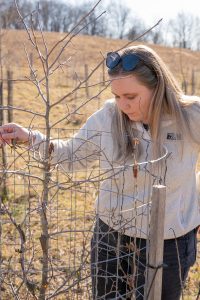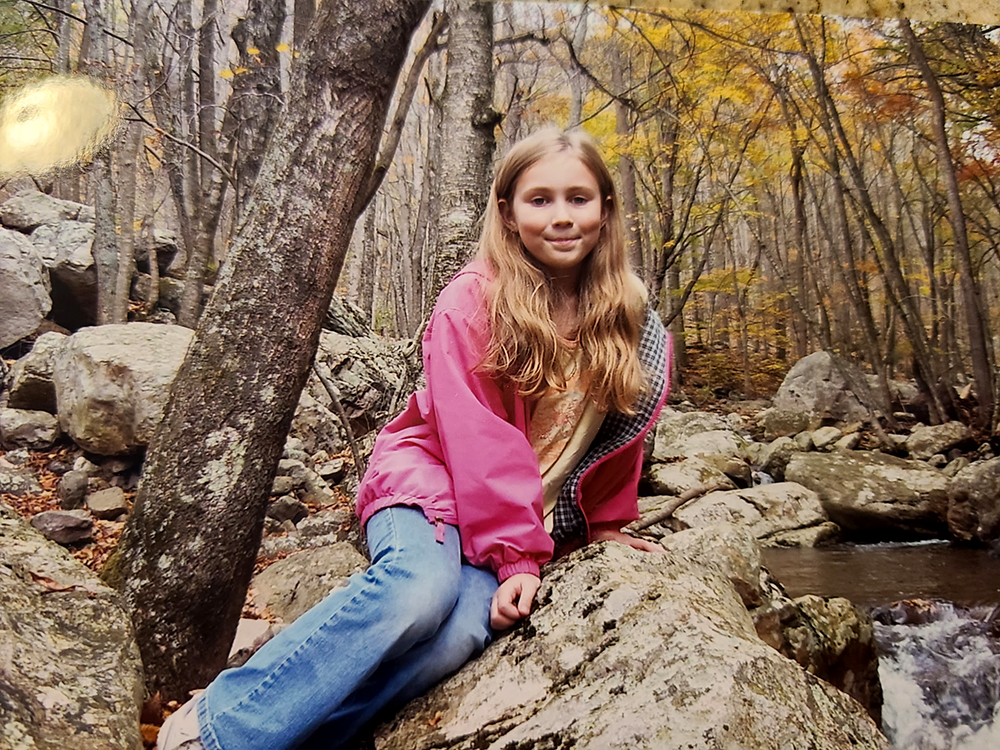
Kara Farthing is Montgomery Planning’s only female arborist – she’s among the 7% of U.S. arborists who are women.
Kara Farthing still remembers her Virginia Tech forestry professor’s advice: Don’t get stuck as the “data fairy.”
During group work in the field, the professor said, female students needed to avoid always ending up as the designated note taker, even if they had the neatest handwriting. Just like their male counterparts, Farthing was told, female students needed to learn to use the forestry equipment, measure trees, and “actually get your hands dirty.”
“It tended to be the woman in the group taking the notes while the guys were out doing something,” Farthing said. The professor “would take the notebook away and hand it to one of the guys, saying to us, ‘You need to be out there. You need to actually be doing this.’”
Today, Farthing is out there getting her hands plenty dirty – and still finds herself navigating a male-dominated field as one of the 7% or so women arborists in the U.S.
Farthing is the only woman among Montgomery Planning’s four arborists. As a forest conservation inspector, she enforces county law requiring developers and property owners to preserve or replace larger trees and forests amid new construction. She ensures they meet the requirements of their approved forest conservation plans to spare certain trees, replace others, prevent invasive species from growing, and protect new plantings from deer.
“I make sure they leave trees alone and they plant back where they’re supposed to,” Farthing said.
She also educates the community about the importance of trees and forests, investigates complaints of trees being improperly cleared, and assesses trees’ health to gauge their risk of falling.
Farthing is responsible for forests east of Interstate 270 and north of the Intercounty Connector (Route 200), an area that includes Olney and Damascus. At any given time, she’s monitoring several dozen construction projects, from shopping centers to subdivisions.
Even in eastern Montgomery’s densely developed suburbs, she said, “There’s a surprising amount of forest” to keep track of.
Christina Sorrento, chief of Montgomery Planning’s Intake and Regulatory Coordination Division, said Farthing and other arborists are key to preserving forests needed for clean air, wildlife habitat, and psychological benefits.
“We have the most stringent forest conservation law in the state,” Sorrento said. “We’re taking big strides to make sure that forest is protected wherever we can and in areas where we can’t, that it’s at least replaced.”
Farthing, she said, brings a “measured” approach to her work and excels at building consensus.
“She’s out in the community all the time,” Sorrento said.
A lifelong love of trees
Farthing grew up south of Richmond loving science and math classes. She spent holidays hiking with her family and climbing trees with cousins and her four older siblings in the woods around their grandparents’ farm in Virginia’s Appalachian region.
“I’ve had a love for trees my entire life,” she said.

Farthing says time with family and friends was often spent exploring and playing outdoors in Virginia where she grew up.
At Virginia Tech, which she graduated from in 2019, she majored in environmental resource management and minored in forestry. She was working for a Frederick engineering firm on air quality issues in 2021 when she saw an opening for her “dream position” of county forest conservation inspector.
Farthing said she enjoys the camaraderie of working in local government and helping to preserve the trees that improve air quality, enrich soil, and form the tree-lined streets that residents love.
“They’re all so unique,” she said of trees. “I think it’s really cool how reliable and strong trees are. … Some of these forests have been there for 70 years, and there’s a lot to learn from them. Also, each tree is just so different, each species of tree and how they react to things. They have different ways of dealing with the elements, and they’ve evolved in different ways. They’re also really pretty.”
At professional conferences and in meetings with developers and property owners, she often finds herself the only woman in the room—or on the construction site. She thinks more women would enter the field if they were exposed to it.
“I’ve had to learn that you don’t have to put on a tough exterior just because you’re in a room full of men,” Farthing said. “You can just be yourself.”
And what would she tell girls or young women thinking about becoming an arborist?
“Don’t let anything stop you,” Farthing said. “If you have an interest or passion, explore it. You have so much to bring to it.”
Carol Thomas
Given her passion and self-confidence , one can only wish Ms Farthing a successful career. As a woman physicist who started her career in the 60’s, I empathize with the challenge of being the only woman in a working group. Perhaps if Ms Farthing were responsible for the county area west of I270 and north of Germantown there would have been more effort by the developer to preserve the mature trees during clearing of High Point Farm (opposite Little Bennet Park on 355 in Clarksburg) for a townhouse development.
Since the County clearly recognizes that “…forests [are] needed for clean air, wildlife habitat, and psychological benefits.” as Ms Sorrento is quoted, one has to wonder when the county /residents will consider law suits based on community health considerations to further restrain developers from felling mature trees. Despite Ms Sorrento’s further statement, we all surely know that a forest cannot be “replaced.”
Various studies have established facts such as that in a report by Ohio State University, for one, that shows it takes 269 sugar maple saplings to equal the carbon storage ability of one large, healthy mature tree, 36” in diameter. A Bristol Tree Forum study reported that, “it will take 25 to 40 years before the replacement trees are able to compensate for the loss of the mature tree.” A US Department of Energy study determined that to capture the same amount of carbon as a large, mature tree, you would need to plant 35 young trees and let them grow for roughly 26 years. (That assumes they all survive.) I refer you to https://www.treeib.com/carbon-storage-in-trees-metric-robert-leverett for the most startling calculations for saplings vs a mature oak. (This isn’t a journal article so I omit full references for the studies cited.)
Let me end this with a personal story: a couple of years ago I noticed that my car registered the temperature in the Neelsville Giant parking lot as 101 F. As I drove home to our house on Peach Tree Rd on a wooded stream valley hill side, I watched the temperature drop: In front of our home, in the woods, it was 83 degrees F.
Sigh.